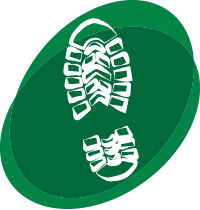Footwear examiners are tasked with comparing an outsole impression (Q) left at a crime scene with an impression (K) from a database or from the suspect’s shoe. We propose semi-automated algorithm, MC-COMP-SURF, for comparing two shoe outsole impressions, that relies on robust features (SURF, Bay et al., 2006) on each impression and aligns them using a maximum clique (MC) approach. After alignment, the algorithm is used to extract additional features that are then combined into a univariate similarity score using a random forest (RF). We use a database of shoe outsole impressions that includes images from two models of athletic shoes worn by study participants for about six months. The shoes share class characteristics, and thus the comparison is challenging. We find that RF-SURF outperforms other methods recently proposed in the literature. In good quality images, the algorithm exhibits accuracy in the 96%-98% range. In more realistic scenarios when Q is degraded and partially observed, MC-COMP-SURF still reaches accuracy of about 88%-90%. The algorithm can be implemented with the R package shoeprintr.
A semi-automated algorithm to quantify similarity between outsole impressions using SURF

Conference/Workshop:
International Association for Identification Educational Conference
International Association for Identification Educational Conference
Published: 2019
Primary Author: Alicia Carriquiry
Secondary Authors: Soyoung Park
Type: Presentation Slides
Research Area: Footwear
Related Resources
Shoeprint Alignment and Comparison using Maximum Cliques
This presentation is from the 107th International Association for Identification (IAI) Annual Educational Conference, National Harbor, Maryland, August 20-26, 2023. Posted with permission of CSAFE.
An algorithm for source identification of footwear impressions—its application on pristine shoeprints and crime-scene like shoeprints
This presentation is from the 107th International Association for Identification (IAI) Annual Educational Conference, National Harbor, Maryland, August 20-26, 2023. Posted with permission of CSAFE.
CSAFE Project Update & ASCLD FRC Collaboration
This presentation highlighted CSAFE’s collaboration with the ASCLD FRC Collaboration Hub.
Source identification of shoeprints in mock crime scene using an algorithm based on automatic alignment
This presentation is from the 75th Anniversary Conference of the American Academy of Forensic Sciences, Orlando, Florida, February 13-18, 2023. Posted with permission of CSAFE


